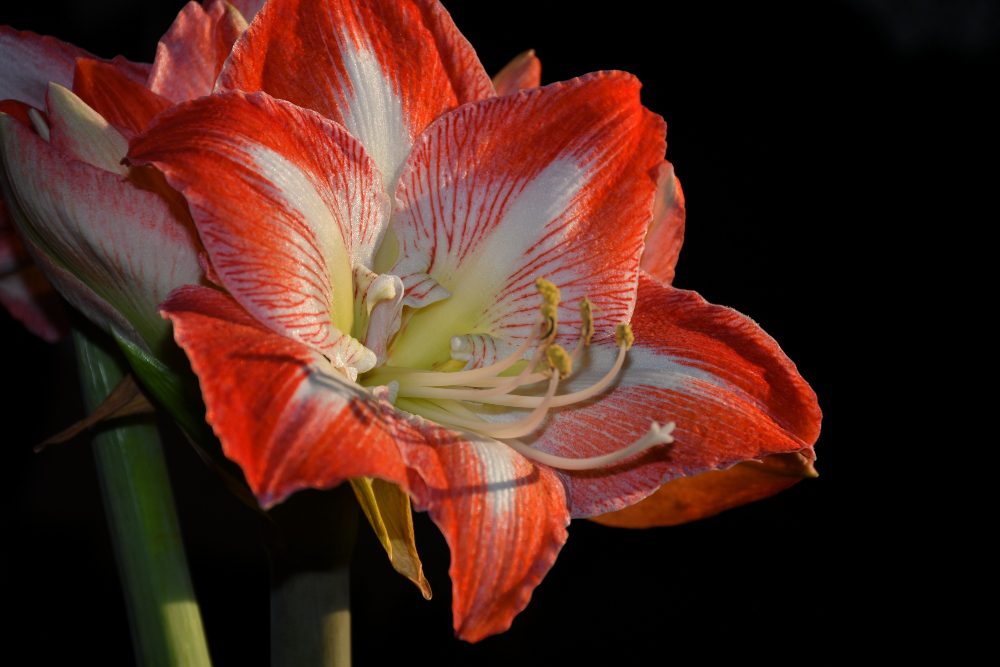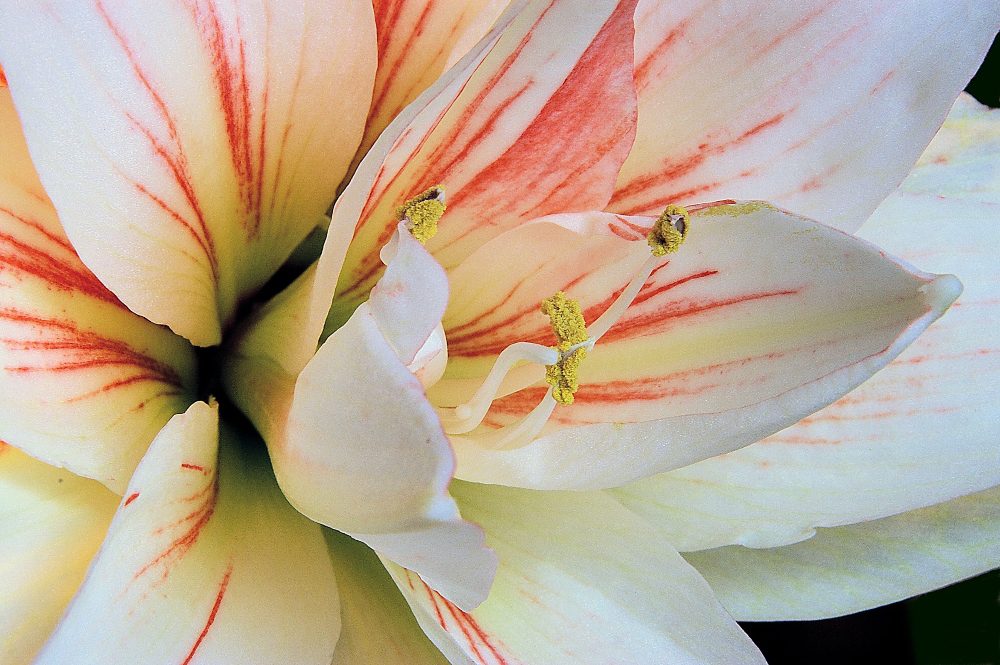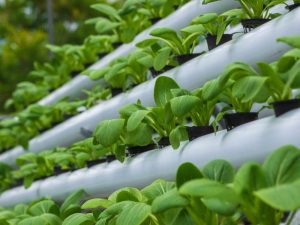
Amaryllis flowers captivate with their stunning trumpet-shaped blooms. This article guides you on how to grow and care for these beautiful plants. Amaryllis is a seasonal delight and a year-round companion for garden enthusiasts. We will delve into practical tips to help your Amaryllis thrive.
Basics of Amaryllis
Contents
- 1 Basics of Amaryllis
- 2 Varieties and Features
- 3 Planting Amaryllis
- 4 Caring for Amaryllis
- 5 FAQ on Amaryllis Flowers
- 5.1 How long does it take for an Amaryllis to bloom?
- 5.2 Can Amaryllis bulbs be reused?
- 5.3 How much light does an indoor Amaryllis need?
- 5.4 Should I deadhead my Amaryllis?
- 5.5 How often should I water my Amaryllis?
- 5.6 Is it normal for Amaryllis leaves to turn yellow after blooming?
- 5.7 Can Amaryllis be grown outdoors?
- 5.8 How do I get my Amaryllis to rebloom?
- 5.9 What are the common pests that affect Amaryllis?
- 5.10 How do I know if I’m over-watering my Amaryllis?
- 6 Conclusion
Amaryllis, a flower of elegance and simplicity, graces many gardens and homes with its vibrant colors and impressive blooms. This section offers insights into its origin, characteristics, and the diversity it brings to the world of flora.
Origin and Characteristics
Amaryllis originates from the tropical regions of South America. Known scientifically as Hippeastrum, these flowers stand out for their large, bell-shaped flowers that grow on tall, sturdy stalks.
Each stalk typically bears two to six flowers, creating a striking display. Amaryllis blooms in various shades, including red, orange, pink, white, and patterns of stripes and speckles. This variety adds a dynamic element to any setting, whether it’s it’sa garden or an indoor space.
Varieties and Features
There are numerous varieties of Amaryllis, each with unique attributes. Some popular types include:
Red Lion
The Red Lion variety of Amaryllis is renowned for its vibrant, deep red petals. These flowers are huge and bold, making a striking statement in any setting. They are a popular choice during the holiday season, often used in festive decorations due to their rich color that complements traditional holiday themes.
The Red Lion blooms are eye-catching and long-lasting, bringing a touch of warmth and joy throughout the winter months.
Apple Blossom
Apple Blossom Amaryllis is a variety that charms with its soft, pastel hues. The petals blend delicate pink and pure white, creating a gentle and serene appearance. This variety is reminiscent of springtime apple blossoms, hence its name. The flowers are known for their graceful form and subtle, inviting fragrance.
Apple Blossom is ideal for creating a soothing and romantic ambiance in any space, whether as a centerpiece or a part of a larger floral arrangement.
Minerva
The Minerva Amaryllis stands out with its bold and dramatic red petals, adorned with contrasting white stripes. This striking pattern catches the eye and adds an artistic flair to the flower’s presentation.
The Minerva blooms are large and showy, making them a focal point in any room or garden. This variety is particularly suited for those who wish to make a vibrant and memorable statement with their floral choices.
Double Dragon
Double Dragon Amaryllis is celebrated for its luxurious, double-flowering blooms. Each flower consists of layers of petals, creating a lush, complete, opulent and elegant look. The petals are typically a deep, rich red, adding to the variety’s regal appearance.
Double Dragon is a favorite among Amaryllis enthusiasts for its unique and extravagant display. It’s an excellent choice for adding a touch of sophistication and depth to floral displays or as a standalone specimen that commands attention.
Picotee
The Picotee Amaryllis variety exudes elegance with its pristine white petals, each delicately outlined with a fine red line. This distinct edge creates a stunning visual contrast, making the blooms stand out in any floral arrangement. The sophistication and refined beauty of Picotee make it a favored choice for formal occasions or as a stylish addition to home decor. Its unique petal edging adds a touch of artistic flair, appealing to those who appreciate subtle yet impactful floral designs.
Lemon Star
Lemon Star Amaryllis brings a cheerful and vibrant energy with its lemon-yellow blooms. This variety’s bright, sunny color instantly uplifts the mood and brightens any room. Ideal for adding a lively splash of color, Lemon Star is perfect for spring and summer displays or to bring a sense of warmth during colder months. This variety pairs well with bold and pastel colors, making it versatile for various decorative themes.
Barbados
The Barbados variety of Amaryllis is known for its luxurious, deep burgundy petals. In certain lighting, these petals can appear almost black, adding a sense of mystery and depth. This variety is ideal for creating a dramatic and sophisticated atmosphere. Its rich, velvety appearance appeals to those who are drawn to bold, intense colors. Barbados is perfect for adding an element of luxury and elegance to both indoor and outdoor spaces.
Dancing Queen
Dancing Queen is a festive and lively Amaryllis variety, featuring double blooms with red and white striped petals. This variety has a playful, party-like appearance that makes it a popular choice for celebrations and festive occasions. The striking stripes create a dynamic visual impact, ensuring that Dancing Queen stands out in any floral display. This variety brings a joyful and exuberant energy, perfect for adding a fun and festive touch to your garden or home.
Exotic Star
The Exotic Star Amaryllis is renowned for its striking star-shaped flowers, a feature that immediately captures attention. The petals display vivid burgundy stripes set against a pale background, creating a dramatic and exotic appearance.
This variety’s unique pattern and shape make it a standout choice for those seeking a bold and unconventional floral display. The Exotic Star Amaryllis is ideal for adding an artistic and captivating touch to any garden or indoor setting.
White Nymph
White Nymph Amaryllis is the epitome of elegance and tranquility. It features lush, double blooms of immaculate white, evoking a serene and peaceful atmosphere. This variety is particularly suited for minimalist or monochromatic color schemes, where its pure white flowers can create a striking impact.
The full, rounded blooms of White Nymph bring a sense of sophistication and grace, making it a perfect choice for formal occasions or as a refined decorative element in home interiors.
Gervase
The Gervase Amaryllis stands out with its enchanting blend of pink, coral, and orange hues, adorned with unique streaks and speckles. Each bloom is slightly different, offering a delightful surprise with every flower.
This variety’s individuality makes it a captivating choice for gardeners and flower enthusiasts who appreciate the uniqueness of their floral displays. The warm and vibrant colors of Gervase make it a cheerful addition to any setting, brightening spaces with its one-of-a-kind beauty.
Mont Blanc
Mont Blanc Amaryllis is named for its majestic and pure white blooms that stand tall and dignified. This variety symbolizes purity and simplicity, making a profound statement with its unadorned elegance.
The pristine white flowers of Mont Blanc offer a versatile aesthetic that complements contemporary and traditional settings. For creating a peaceful and calming environment, Mont Blanc Amaryllis is a favorite for those who prefer classic beauty and understated charm in their floral choices.
Each variety of Amaryllis has its blooming period and care requirements. Understanding these nuances is crucial for nurturing these flowers to their full potential. Whether you are a seasoned gardener or a beginner, Amaryllis offers a rewarding experience with its splendid blooms and relatively easy care.
Each variety of Amaryllis has its blooming period and care requirements. Understanding these nuances is crucial for nurturing these flowers to their full potential. Whether you are a seasoned gardener or a beginner, Amaryllis offers a rewarding experience with its splendid blooms and relatively easy care.

Planting Amaryllis
Planting and growing Amaryllis is an exciting venture. This section guides you through the essential steps for successful planting. From choosing the right bulbs to understanding the ideal planting conditions, these insights ensure your Amaryllis gets the best start.
Selecting the Right Bulbs
Choosing the suitable Amaryllis bulbs ensures a beautiful display of blooms. This section provides essential tips to help you select healthy, robust bulbs that promise vibrant flowers.
Understanding Bulb Quality
Amaryllis bulbs come in various sizes, with larger bulbs often producing more stalks and blooms. Look for firm and dry bulbs with no signs of mold, rot, or damage. The quality of the bulb directly impacts the growth and flowering potential, making this an important consideration.
Tips for Choosing Healthy Amaryllis Bulbs
- Size Matters: Generally, more giant bulbs yield more flowers. Choose bulbs proportionate to the variety of Amaryllis you’re interested in.
- Inspect the Surface: The bulb should be firm to the touch and free of any cuts, bruises, or soft spots. This indicates good health and a lower risk of disease.
- Check for Dryness: The outer layers of the bulb should be dry and papery. Moisture can be a sign of decay or improper storage.
- Root Inspection: Healthy bulbs often have visible, dried roots at the base. This is a good sign of a viable bulb ready to grow.
- Avoid Sprouted Bulbs: Choose bulbs that haven’t sprouted yet. While sprouted bulbs can still grow, un-sprouted bulbs often adapt better to new planting conditions.
Preparing for Planting
Proper preparation of the soil and planting environment is essential for the thriving growth of Amaryllis. This section covers the key aspects of preparing the ideal setting for your bulbs to flourish.
Ideal Soil Composition
Amaryllis bulbs thrive in well-drained soil that retains enough moisture without becoming waterlogged. A mix of potting soil, perlite, and coarse sand is often ideal. This combination provides the right balance of drainage and nutrient retention. The pH should be slightly acidic to neutral.
Quality Potting Soil
The foundation for healthy Amaryllis growth is high-quality potting soil. This soil should have several characteristics:
- Rich in Organic Matter: Organic matter, such as compost or peat moss, provides essential nutrients and helps retain moisture. It feeds the bulb as it grows, supporting robust development.
- Light and Airy Texture: The soil must not be too dense. A light, porous texture allows air to reach the roots, promoting healthy growth. This texture also facilitates proper root expansion, which is crucial for the plant’s overall health.
- Good Drainage Properties: While retaining moisture is important, the soil must allow excess water to drain. This balance prevents waterlogging, which can harm the bulb.
Adding Drainage Materials
Proper drainage is key to preventing root rot in the Amaryllis. Here’s how to enhance soil drainage:
- Use of Perlite: Perlite is a volcanic glass that improves aeration and drainage in the soil. When mixed with potting soil, it creates spaces that allow water to flow freely and air to reach the roots.
- Incorporating Coarse Sand: Coarse sand is another excellent material for improving drainage. It prevents the soil from compacting, which can otherwise restrict water flow and root growth.
- Balanced Mixture: The goal is to create a soil mix that holds moisture long enough to benefit the plant but drains any excess quickly. A blend of one-third potting soil, one-third perlite, and one-third coarse sand is often effective.

Ensuring Nutrient Balance
Amaryllis thrives in nutrient-rich soil, but it doesn’t require excessive feeding. Here’s how to ensure a balanced nutrient supply:
- Slow-Release Fertilizer: Integrating a slow-release fertilizer into the soil mix provides a steady supply of nutrients over time. This is crucial during the growing phase, as it supports the development of strong stalks and vibrant blooms.
- Types of Fertilizers: Look for fertilizers that are balanced in nitrogen, phosphorus, and potassium. A formulation like 10-10-10 or similar is usually suitable for Amaryllis.
- Application Timing: The best time to add fertilizer is during potting and just before the growing season. This ensures the nutrients are available when the plant needs them most.
- Avoiding Over-Fertilization: It’s important not to over-fertilize, as this can lead to lush foliage at the expense of blooms. Follow the instructions on the fertilizer package for the best results.
Pot Selection
The right pot is crucial for the health of your Amaryllis. Consider these factors when choosing a pot:
- Size and Fit: The pot should be slightly larger than the bulb, with about an inch of space around it. This space is necessary for root growth and adequate soil coverage.
- Drainage Holes: Ensure the pot has drainage holes at the bottom. These are vital for allowing excess water to escape preventing bulb rot and fungal infections.
- Material Considerations: Pots can be made of various materials, such as terracotta, plastic, or ceramic. Terracotta is porous, offering good air circulation but may dry out faster. Plastic and ceramic pots retain moisture longer but can restrict air flow if not properly managed.
- Stability: Amaryllis flowers can be top-heavy when in bloom, so a stable pot is important to prevent tipping. A heavier pot with a wider base can provide the necessary stability.
Planting Techniques
Proper planting techniques are essential for the successful growth of Amaryllis. This section will guide you through the steps to ensure your Amaryllis bulbs are planted correctly, setting the stage for vibrant blooms.
Proper Planting Depth and Spacing
- Depth: Plant Amaryllis bulbs so that the top third of the bulb is above the soil surface. This exposure is crucial for proper growth.
- Spacing: If planting multiple bulbs, maintain a gap of about 8 to 12 inches between them. This space allows each plant enough room to grow without competing for nutrients.
Orientation and Positioning of Bulbs
- Bulb Orientation: Ensure the pointed end of the bulb faces upwards. This is where the stalk and flowers will emerge.
- Positioning in Pot: Center the bulb, allowing for even growth and stability. Ensure the roots are spread out and not cramped.
Prepare the Pot and Soil
- Choosing the Right Pot: As previously discussed, ensure your pot has adequate drainage and is the correct size.
- Filling the Pot: Fill the pot with your prepared soil mix, leaving about one-third of the pot empty. This space is for placing the bulb and adding extra soil later.
- Soil Preparation: If you haven’t already mixed in slow-release fertilizer, now is a good time to ensure an even distribution throughout the soil.
Place the Bulb
- Handling the Bulb: Carefully hold the Amaryllis bulb, avoiding pressure on the roots.
- Positioning the Bulb: Place the bulb in the center of the pot. The pointed end, from which the plant will grow, should face upwards.
- Securing the Bulb: Gently press the bulb into the soil to anchor it. Be careful not to push too hard, as this could damage the bulb’s roots or base.
Add More Soil
- Covering the Bulb: Scoop more soil and sprinkle it around the bulb. Ensure the sides are covered while exposing the bulb’s top third.
- Settling the Soil: Gently pat the soil around the bulb. This step helps to remove air pockets and provides a stable base for the bulb. However, avoid compacting the soil too tightly, hindering root growth.
Watering After Planting
- Initial Watering: Once the bulb is planted and the soil is in place, water the soil thoroughly. This initial watering helps to settle the soil around the bulb and provides the moisture needed to start the growth process.
- Subsequent Watering: After the initial watering, reduce the frequency. Water sparingly until you see growth, typically the first shoots. Overwatering before the plant establishes can lead to bulb rot.

Optimal Planting Conditions
Creating the right conditions for planting Amaryllis is key to a successful bloom. This section covers the ideal location, light, and temperature for planting Amaryllis.
Choosing the Best Location
- Indoor Planting: If you’re planting Amaryllis indoors, select a spot that receives bright, indirect sunlight. A south or west-facing window is often ideal.
- Outdoor Planting: Choose a location with partial to full sunlight for outdoor planting. Protect the plants from strong winds and extreme weather conditions.
Understanding Light Needs
- Light Intensity: Amaryllis requires bright light to flourish. However, too much direct sunlight can scorch the leaves, especially in hotter climates.
- Duration of Light: Aim for at least 6 to 8 hours of good light daily. Consistent light exposure is important for steady growth and blooming.
Temperature Requirements for Planting
- Ideal Temperature Range: Amaryllis prefers temperatures between 65°F to 75°F (18°C to 24°C). This range is optimal for growth and flowering.
- Avoiding Temperature Extremes: Protect the plant from extreme heat or cold. Temperature fluctuations can stress the plant, affecting its growth and bloom cycle.
Caring for Amaryllis
Once your Amaryllis is planted, proper care is essential for ensuring vibrant blooms and a healthy plant. This section will cover the key aspects of caring for Amaryllis, from watering to maintenance.
Watering Requirements
Before watering, check that the top inch of soil is dry. Over-watering can cause the bulb to rot, a common problem with Amaryllis. Water at the base of the plant to avoid wetting the foliage. Use water at room temperature to avoid shocking the plant.
Water needs depend on factors like light, temperature, and humidity. In brighter, warmer conditions, Amaryllis may need more frequent watering. Reduce watering frequency after the bloom period as the plant enters a dormant phase.
Use pots with drainage holes to prevent water accumulation at the bottom. Excess water should easily drain out. To prevent waterlogging, keep an eye on the moisture level, especially in humid environments.
Sunlight and Temperature Needs
Place the plant where it receives bright but indirect sunlight, such as near a window with sheer curtains. Rotate the pot regularly to ensure light exposure, promoting balanced growth.
Keep the room at a consistent temperature within the 65°F to 75°F range. Fluctuations in temperature can stress the plant. Keep the plant away from cold drafts or heating vents. Sudden temperature changes can be detrimental to the plant’s health.
Removing Spent Blooms
When an Amaryllis bloom starts to fade and wilt, it’s time to prune it. This prevents the plant from expending energy on seed production. Use clean, sharp scissors or pruning shears. Cut the stem close to the top of the bulb, being careful not to damage the foliage. Removing spent blooms can encourage the plant to focus its energy on developing new flowers.
Leaf Care
The leaves of Amaryllis are crucial for photosynthesis, which nourishes the bulb. Even after the blooms have faded, the leaves continue to provide energy to the bulb. Keep the leaves clean and dust-free. Wipe them gently with a damp cloth if necessary. Be careful not to damage the leaves while pruning. Damaged leaves can affect the plant’s overall health.
Post-Bloom Care
After all the flowers have bloomed and faded, cut the stalks back to an inch above the bulb. This helps prevent rot and disease. Continue to water and care for the plant, allowing the leaves to remain until they begin to yellow. This period is essential for the bulb to store energy for the next blooming cycle. As the leaves start to die back, gradually reduce watering. This signals to the bulb that it’s time to enter a dormant phase.
FAQ on Amaryllis Flowers
How long does it take for an Amaryllis to bloom?
Can Amaryllis bulbs be reused?
How much light does an indoor Amaryllis need?
Should I deadhead my Amaryllis?
How often should I water my Amaryllis?
Is it normal for Amaryllis leaves to turn yellow after blooming?
Can Amaryllis be grown outdoors?
How do I get my Amaryllis to rebloom?
What are the common pests that affect Amaryllis?
How do I know if I’m over-watering my Amaryllis?
Conclusion
Growing and caring for Amaryllis offers a rewarding experience filled with vibrant colors and elegant blooms. By understanding the nuances of planting, caring for, and maintaining these beautiful flowers, gardeners and plant enthusiasts can enjoy the splendid display that Amaryllis brings.








